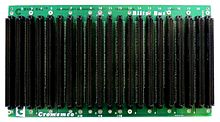S-100 bus
The S-100 bus was an early computer bus designed as part of the Altair 8800 , which is now considered the first personal computer . The S-100 bus was the first bus to be a kind of industry standard . S-100 computers, processors and peripherals were manufactured by several manufacturers from 1975 to around 1985.
During the design of the Altair, it quickly became clear that the hardware needed to make a usable machine would not be available in time for sales in January 1975. The designer, Ed Roberts , also had problems with the motherboard , which just took up too much space. To solve these problems, he packed the existing components in a case with additional slots so that the missing hardware could be added later as it became available. The motherboard has been split into four different cards, with the CPU on a fifth. Then he was looking for a cost-effective source for plug-in connections and stumbled over a 100-pinnigen edge connector ( edge connector ), the basis for the S-100 bus has been.
The most important feature of this bus is that it essentially consists of the pins from the Intel 8080 , which are only extended onto the board. Not too much (thought) work was invested in the design of the bus, which resulted in such disasters as several power supply lines with different voltages directly next to each other, which almost provoked a short circuit. Another absurdity: the system contained two unidirectional 8-bit data buses, but only one bidirectional 16-bit address bus. A bargain when shopping for power supplies meant that +8 V and +18 V were used as voltages on the bus, which were generated on the cards by heating up the excess to the much more frequently used levels TTL (+5 V) or RS-232 ( +12 V) had to be regulated down.
Despite these shortcomings, the S-100 bus developed from this point on into the standard bus for professional personal computers, almost all of which ran under the CP / M operating system . The standard was so strong that many CPU designs were either modified to look like the 8080, or they were installed on so-called converter cards, which allowed them to run in S-100 machines. Only the widespread use of the IBM PC and its clones , with their own bus system ( XT bus architecture ), put an end to the S-100 bus.
A number of versions of the S-100 bus existed from different manufacturers, but the bus was standardized as IEEE 696 in 1982 (when its use was already coming to an end) .
Web links
- S-100 and IEEE-696 Bus List at retrotechnology.com (English)

